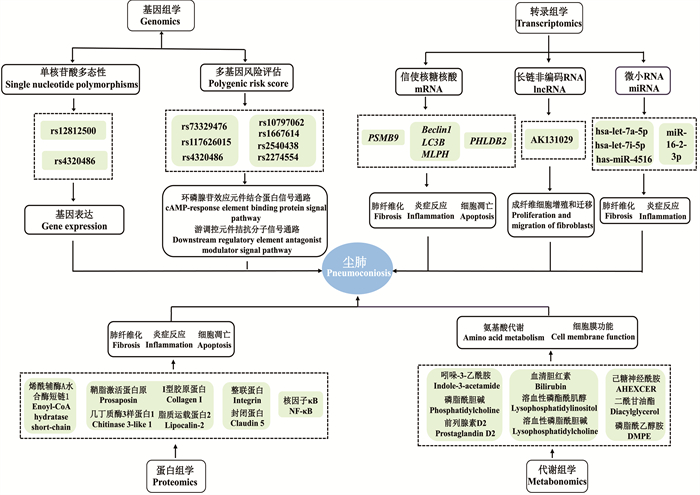| [1] |
中华预防医学会劳动卫生与职业病分会职业性肺部疾病学组. 尘肺病治疗中国专家共识(2018年版)[J]. 环境与职业医学, 2018, 35(8): 677-689. DOI: 10.13213/j.cnki.jeom.2018.18437.Occupational Lung Diseases Group, Occupational Health and Occupational Diseases Branch, Chinese Preventive Medical Association. Consensus of Chinese experts on pneumoconiosis treatment (2018)[J]. Journal of Environmental and Occupational Medicine, 2018, 35(8): 677-689. DOI: 10.13213/j.cnki.jeom.2018.18437.
|
| [2] |
Wang HQ, Jia JL, Jiang ZQ, et al. Analysis of Health Service Utilization and its Influencing Factors among Patients with Pneumoconiosis in China[J]. Biomed Environ Sci, 2021, 34(1): 83-88. DOI: 10.3967/bes2021.011.
|
| [3] |
徐海明, 刘科良, 郝艳星, 等. 生物标志物的联合检测对矽肺早期辅助诊断的价值[J]. 癌变·畸变·突变, 2020, 32(5): 395-397, 401. https://www.cnki.com.cn/Article/CJFDTOTAL-ABJB202005014.htmXu HM, Liu KL, Hao YX, et al. Usefulness of combined application of biomarkers in early auxiliary diagnosis of silicosis[J]. Carcinogenesis, Teratogenesis & Mutagenesis, 2020, 32(5): 395-397, 401. https://www.cnki.com.cn/Article/CJFDTOTAL-ABJB202005014.htm
|
| [4] |
Chu M, Wu S, Wang W, et al. Functional variant of the carboxypeptidase M (CPM) gene may affect silica-related pneumoconiosis susceptibility by its expression: a multistage case-control study[J]. Occup Environ Med, 2019, 76(3): 169-174. DOI: 10.1136/oemed-2018-105545.
|
| [5] |
Ji X, Wu B, Han R, et al. The association of LAMB1 polymorphism and expression changes with the risk of coal workers' pneumoconiosis[J]. Environ Toxicol, 2017, 32(9): 2182-2190. DOI: 10.1002/tox.22431.
|
| [6] |
杭栋, 沈洪兵. 多基因风险评分与复杂性疾病风险预测和精准预防: 机遇和挑战[J]. 中华流行病学杂志, 2019, 40(9): 1027-1030. DOI: 10.3760/cma.j.issn.0254-6450.2019.09.001.Hang D, Shen HB. Application of polygenic risk scores in risk prediction and precision prevention of complex diseases: opportunities and challenges[J]. Chin J Epidemiol, 2019, 40(9): 1027-1030. DOI: 10.3760/cma.j.issn.0254-6450.2019.09.001.
|
| [7] |
Chu M, Ji X, Chen W, et al. A genome-wide association study identifies susceptibility loci of silica-related pneumoconiosis in Han Chinese[J]. Hum Mol Genet, 2014, 23(23): 6385-6394. DOI: 10.1093/hmg/ddu333.
|
| [8] |
Sponchiado M, Bonilla AL, Mata L, et al. Loss of club cell creb mitigates IL-1B-mediated muco-obstructive phenotypes in male murine airways[J]. FASEB J, 2022, 36. DOI: 10.1096/fasebj.2022.36.s1.r5228.
|
| [9] |
Jenkins G. Demystifying pulmonary fibrosis[J]. Am J Physiol Lung Cell Mol Physiol, 2020, 319(3): L554-L559. DOI: 10.1152/ajplung.00365.2020.
|
| [10] |
Zamaraev AV, Zhivotovsky B, Kopeina GS. Viral infections: negative regulators of apoptosis and oncogenic factors[J]. Biochemistry Moscow, 2020, 85(10): 1191-1201. DOI: 10.1134/S0006297920100077.
|
| [11] |
Wang T, Li Y, Zhu M, et al. Association analysis identifies new risk loci for coal workers' pneumoconiosis in Han Chinese men[J]. Toxicol Sci, 2018, 163(1): 206-213. DOI: 10.1093/toxsci/kfy017.
|
| [12] |
Ge D, Shao Y, Wang M, et al. RNA-seq-based screening in coal dust-treated cells identified PHLDB2 as a novel lung cancer-related molecular marker[J]. Biomed Res Int, 2021, 2021: 1978434. DOI: 10.1155/2021/1978434.
|
| [13] |
Yuan J, Wang T, Wang L, et al. Transcriptome-wide association study identifies PSMB9 as a susceptibility gene for coal workers' pneumoconiosis[J]. Environ Toxicol, 2022, 37(8): 2103-2114. DOI: 10.1002/tox.23554.
|
| [14] |
Mu M, Li B, Zou Y, et al. Coal dust exposure triggers heterogeneity of transcriptional profiles in mouse pneumoconiosis and Vitamin D remedies[J]. Part Fibre Toxicol, 2022, 19(1): 7. DOI: 10.1186/s12989-022-00449-y.
|
| [15] |
Wang W, Mu M, Zou Y, et al. Glycogen metabolism reprogramming promotes inflammation in coal dust-exposed lung[J]. Ecotoxicol Environ Saf, 2022, 242: 113913, DOI: 10.1016/j.ecoenv.2022.113913.
|
| [16] |
Slack FJ, Chinnaiyan AM. The role of non-coding RNAs in oncology[J]. Cell, 2019, 179(5): 1033-1055. DOI: 10.1016/j.cell.2019.10.017.
|
| [17] |
Lei X, Qing A, Yuan X, et al. A landscape of lncRNA expression profile and the predictive value of a candidate lncRNA for silica-induced pulmonary fibrosis[J]. DNA Cell Biol, 2020. DOI: 10.1089/dna.2020.5531.
|
| [18] |
Krause HM. New and prospective roles for lncRNAs in organelle formation and function[J]. Trends Genet, 2018, 34(10): 736-745. DOI: 10.1016/j.tig.2018.06.005.
|
| [19] |
Li X, Yu T, Shan H, et al. lncRNA PFAL promotes lung fibrosis through CTGF by competitively binding miR-18a[J]. FASEB J, 2018, 32(10): 5285-5297. DOI: 10.1096/fj.201800055R.
|
| [20] |
Lu Q, Guo Z, Xie W, et al. The lncRNA H19 mediates pulmonary fibrosis by regulating the miR-196a/COL1A1 axis[J]. Inflammation, 2018, 41(3): 896-903. DOI: 10.1007/s10753-018-0744-4.
|
| [21] |
Zhang L, Hao C, Yao S, et al. Exosomal miRNA profiling to identify nanoparticle phagocytic mechanisms[J]. Small, 2021, 17(31): 2103783. DOI: 10.1002/smll.202103783.
|
| [22] |
Huang R, Yu T, Li Y, et al. Upregulated has-miR-4516 as a potential biomarker for early diagnosis of dust-induced pulmonary fibrosis in patients with pneumoconiosis[J]. Toxicol Res, 2018, 7(3): 415-422. DOI: 10.1039/c8tx00031j.
|
| [23] |
Shi X, Bai Y, Gao Y, et al. Comprehensive analysis of differentially expressed lncRNAs miRNAs and mRNA and their ceRNA network of patients with rare-earth pneumoconiosis[J]. Front Genet, 2021, 12: 700398. DOI: 10.3389/fgene.2021.700398.
|
| [24] |
张明, 曾强, 杨德一, 等. 粉尘接触人群血清微小RNA表达研究[J]. 中国职业医学, 2016, 43(2): 178-180. DOI: 10.11763/j.issn.2095-2619.2016.02.013.Zhang M, Zeng Q, Yang DY, et al. MicroRNA expression in the serum of dust exposure population[J]. Chin Occup Med, 2016, 43(2): 178-180. DOI: 10.11763/j.issn.2095-2619.2016.02.013.
|
| [25] |
刘义涛, 王凤山, 曾强, 等. 粉尘作业工人接尘年限与血清miR-21和miR-204相关性研究[J]. 环境与健康杂志, 2019, 36(2): 134-136. DOI: 10.16241/j.cnki.1001-5914.2019.02.010.Liu YT, Wang FS, Zeng Q, et al. Relationship between serum miR-21, miR-204 expression and dust exposure time in dust-exposed workers[J]. J Environ Health, 2019, 36(2): 134-136. DOI: 10.16241/j.cnki.1001-5914.2019.02.010.
|
| [26] |
Hornung V, Bauernfeind F, Halle A, et al. Silica crystals and aluminum salts activate the NALP3 inflammasome through phagosomal destabilization[J]. Nat Immunol, 2008, 9(8): 847-856. DOI: 10.1038/ni.1631.
|
| [27] |
Benmerzoug S, Rose S, Bounab B, et al. STING-dependent sensing of self-DNA drives silica-induced lung inflammation[J]. Nat Commun, 2018, 9(1): 5226. DOI: 10.1038/s41467-018-07425-1.
|
| [28] |
Zhu Y, Yao JX, Xu H, et al. Proteomic profile of silicotic rats identifies PTPN2, VRK1, and B-factor as new biomarkers of pneumoconiosis[J]. SSRN J, 2019. DOI: 10.2139/ssrn.3417859.
|
| [29] |
Bo C, Geng X, Zhang J, et al. Comparative proteomic analysis of silica-induced pulmonary fibrosis in rats based on tandem mass tag (TMT) quantitation technology[J]. PLoS One, 2020, 15(10): e0241310. DOI: 10.1371/journal.pone.0241310.
|
| [30] |
Bo C, Zhang J, Sai L, et al. Integrative transcriptomic and proteomic analysis reveals mechanisms of silica-induced pulmonary fibrosis in rats[J]. BMC Pulm Med, 2022, 22(1): 13. DOI: 10.1186/s12890-021-01807-w.
|
| [31] |
Iijima J, Kobayashi S, Kitazume S, et al. Core fucose is critical for CD14-dependent Toll-like receptor 4 signaling[J]. Glycobiology, 2017, 27(11): 1006-1015. DOI: 10.1093/glycob/cwx075.
|
| [32] |
Clayton GM, Wang Y, Crawford F, et al. Structural basis of chronic beryllium disease: linking allergic hypersensitivity and autoimmunity[J]. Cell, 2014, 158(1): 132-142. DOI: 10.1016/j.cell.2014.04.048.
|
| [33] |
Gong Y, Wang H, Kan L, et al. Differential proteins in alveolar macrophages in patients with different stages of silicosis[J]. Int J Clin Exp Med, 2022, 15(3): 78-96.
|
| [34] |
Fu R, Li Q, Fan R, et al. iTRAQ-based secretome reveals that SiO2 induces the polarization of RAW264.7 macrophages by activation of the NOD-RIP2-NF-κB signaling pathway[J]. Environ Toxicol Pharmacol, 2018, 63: 92-102. DOI: 10.1016/j.etap.2018.08.010.
|
| [35] |
Zhang J, Yang X, Yang Y, et al. NF-κB mediates silica-induced pulmonary inflammation by promoting the release of IL-1β in macrophages[J]. Environ Toxicol, 2022, 37(9): 2235-2243. DOI: 10.1002/tox.23590.
|
| [36] |
姚三巧, 杨宁伟, 郭菲菲, 等. Th1/Th2细胞因子在暴露粉尘工人血清中的表达及在煤工尘肺监测中的价值[J]. 中华预防医学杂志, 2018, 52(11): 1158-1163. DOI: 10.3760/cma.j.issn.0253-9624.2018.11.012.Yao SQ, Yang NW, Guo FF, et al. Expression of type 1 and type 2 cytokines from serum of coal miners and the evaluation in surveillance of coal workers' pneumoconiosis at earlier stage[J]. Chi J Prev Med, 2018, 52(11): 1158-1163. DOI: 10.3760/cma.j.issn.0253-9624.2018.11.012.
|
| [37] |
Zhou M, Xue C, Fan Y, et al. Plasma metabolic profiling in patients with silicosis and asbestosis[J]. J Occup Environ Med, 2021, 63(9): 787-793. DOI: 10.1097/JOM.0000000000002232.
|
| [38] |
Wang H, Zhou S, Liu Y, et al. Exploration study on serum metabolic profiles of Chinese male patients with artificial stone silicosis, silicosis, and coal worker's pneumoconiosis[J]. Toxicol Lett, 2022, 356: 132-142. DOI: 10.1016/j.toxlet.2021.11.011.
|
| [39] |
Xue C, Wu N, Fan Y, et al. Distinct metabolic features in the plasma of patients with silicosis and dust-exposed workers in China: a case-control study[J]. BMC Pulm Med, 2021, 21(1): 91. DOI: 10.1186/s12890-021-01462-1.
|
| [40] |
Pang J, Qi X, Luo Y, et al. Multi-omics study of silicosis reveals the potential therapeutic targets PGD2 and TXA2[J]. Theranostics, 2021, 11(5): 2381-2394. DOI: 10.7150/thno.47627.
|
| [41] |
Olivier M, Asmis R, Hawkins GA, et al. The need for multi-omics biomarker signatures in precision medicine[J]. Int J Mol Sci, 2019, 20(19): 4781. DOI: 10.3390/ijms20194781.
|
| [42] |
Peng F, Dai J, Qian Q, et al. Serum metabolic profiling of coal worker's pneumoconiosis using untargeted lipidomics[J]. Environ Sci Pollut Res, 2022, 29(56): 85444-85453. DOI: 10.1007/s11356-022-21905-4.
|
| [43] |
Chen Z, Shi J, Zhang Y, et al. Lipidomics profiles and lipid metabolite biomarkers in serum of coal workers' pneumoconiosis[J]. Toxics, 2022, 10(9): 496. DOI: 10.3390/toxics10090496.
|





 下载:
下载:

